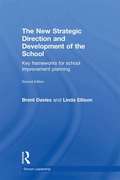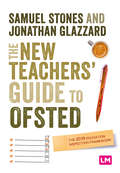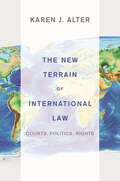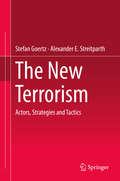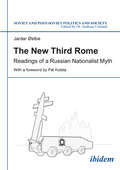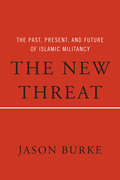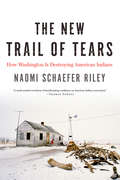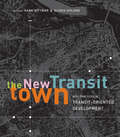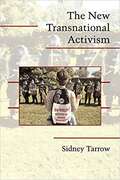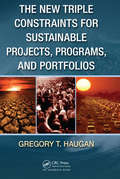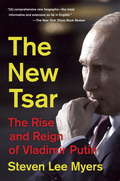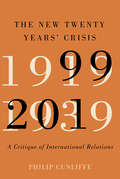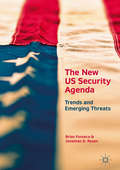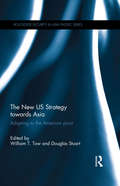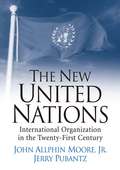- Table View
- List View
The New Strategic Direction and Development of the School: Key Frameworks for School Improvement Planning (School Leadership)
by Brent Davies Linda EllisonSchools will not be able to continue to improve unless they move away from an over-concentration on the short-term and focus on the strategic nature of planning and development. The more targets, the less the effects - what we need is strategy and sustainability. This book links school improvement planning and strategic development for leadership enhancement as well as for management accountability. Short-term planning, in the form of target-setting plans aimed at improving standards, has gained increasing importance. While the book agrees that this is necessary, it puts forward the view that short-term planning is not sufficient for the longer-term development of the school. Sustainability and strategic development are of critical importance and for these the authors believe that a more holistic approach to planning is necessary. To that end, this book links short and longer-term planning in a framework, which supports the strategic development of the school. The authors are national experts in the field and in preparing this text have worked extensively with headteachers, deputy headteachers, governors and those participating in NPQH and masters programmes in educational leadership and management.
The New Structural Social Work: Ideology, Theory, Practice
by Bob MullalyThe New Structural Social Work reveals the shortcomings of conventional social work, which accepts and participates in the present social order rather than addressing the systemic social problems that exist within capitalist societies. Mullaly advocates for a progressive view of social work that is practiced within the social agency, outside of the agency, and within the personal lives of structural social workers.
The New Student Activists: The Rise of Neoactivism on College Campuses
by Jerusha O. ConnerMeet the new breed of student activists—uncompromising, focused, and connected.Activism is once again back on college campuses as students protest issues such as sexual assault, climate change, racial injustice, and student debt. It's perhaps unsurprising that the current political moment has triggered the rise of a new breed of student activist—uncompromising, focused, and connected. But many pundits have variously derided student activists as either "snowflakes," too fragile to encounter opinions that run contrary to their own, or as "social justice warriors" who aggressively fight against those who transgress the ever-changing bounds of political correctness. The New Student Activists moves beyond these simple stereotypes and convenient caricatures to examine the nuanced motives and complex experiences of real-life, present-day college student activists.Jerusha O. Conner offers insight into who these student activists are—the causes they care about, the strategies they deploy, the factors that motivate and sustain them, and the impact they have had on their campuses and beyond. Conner dubs today's student activists "neoactivists," who borrow from and build on the legacies of past generations of college student activists. Exploring when, how, and why this diverse group of students turned to activism, Conner examines the social and educational influences on their sociopolitical development. She also reveals the fraught but mutually transformative relationship between institutions of higher education and student activists in the contemporary moment. Written for anyone interested in better understanding the latest wave of student activism on campuses, The New Student Activists raises fascinating implications for developmental theory and higher education policy and practice.
The New Suburbanization: Challenge To The Central City
by Penny Peace Thomas M Stanback JrIn this book fourteen large metropolitan economies are examined to show how industrial composition and jobs have changed in central cities and suburbs since 1970. Driven by the shift in emphasis from goods toward services, both central cities and suburbs have undergone dramatic changes. The analysis shows that many large central cities have experienced wrenching transformations as a result of low growth or declines in employment and population. However, these cities have continued to be the focal point of economic activity within the metropolis, becoming more narrowly specialized in high-level services, which have yielded higher average earnings. These cities are becoming increasingly dependent on commuting suburbanites for their experienced and educated labor force. In the suburbs, the cumulative effect of continuous growth since World War II has brought a different sort of transformation. The composition of employment has broadened, with sharp increases in commuting from areas outside the suburbs. Major new centers of business, consumer, and social services have developed, giving rise to agglomeration economies and posing new challenges to the social and economic structure of the central city. The book also examines employment opportunities in central cities and in suburbs with special emphasis on jobs for blacks, women, and young workers. Analysis reveals the increasing importance of educational qualifications and the role of part-time work and focuses on the problems central city blacks face in gaining employment. The prospects for city dwellers seeking suburban jobs are often limited by housing and transportation restrictions. The book closes with a critical review of suggested policy alternatives that might increase access to employment for these workers.
The New Teacher’s Guide to OFSTED: The 2019 Education Inspection Framework (Ready to Teach)
by Jonathan Glazzard Samuel StonesWhat does the new OFSTED framework mean for new and trainee teachers? How will it change what happens in schools and classrooms? This new text guides new and trainee teachers through all they need to know about the 2019 OFSTED inspection. It supports them to understand and reflect on the context of the new framework - as professionals. It dispels many of the myths that new teachers will hear in schools and provides much needed clarity and detail. This book: · Explores the context of the publication of the new framework and what this might mean for schools and teachers · Supports teachers to understand how the framework links to what happens in classroom and to school level priorities from SLT · Includes examples of outstanding practice to learn from · Features a mythbusting section to help teachers to understand the facts about OFSTED · Supports new teachers to understand, prepare for and approach OFSTED inspections with confidence and clarity of purpose.
The New Teacher’s Guide to OFSTED: The 2019 Education Inspection Framework (Ready to Teach)
by Jonathan Glazzard Samuel StonesWhat does the new OFSTED framework mean for new and trainee teachers? How will it change what happens in schools and classrooms? This new text guides new and trainee teachers through all they need to know about the 2019 OFSTED inspection. It supports them to understand and reflect on the context of the new framework - as professionals. It dispels many of the myths that new teachers will hear in schools and provides much needed clarity and detail. This book: · Explores the context of the publication of the new framework and what this might mean for schools and teachers · Supports teachers to understand how the framework links to what happens in classroom and to school level priorities from SLT · Includes examples of outstanding practice to learn from · Features a mythbusting section to help teachers to understand the facts about OFSTED · Supports new teachers to understand, prepare for and approach OFSTED inspections with confidence and clarity of purpose.
The New Technocracy
by Anders EsmarkThe rise of populist parties and movements across the Western hemisphere and their contempt for ‘experts’ has shocked the establishment. This book examines how the ‘post-industrial’ technocratic regime of the 1980’s – of managerialism, depoliticisation and the politics of expertise – sowed the seeds for the backlash against the political elites that is visible today. Populism, Esmark augues, is a sign that the technocratic bluff has finally been called and that technocracy posing as democracy will only serve to exasperate existing problems. This book sets a new benchmark for studies of technocracy, showing that a solution to the challenge of populism will depend as much on a technocratic retreat as democratic innovation.
The New Terrain of International Law: Courts, Politics, Rights
by Karen J. AlterA compelling new look at the role of today's international courtsIn 1989, when the Cold War ended, there were six permanent international courts. Today there are more than two dozen that have collectively issued over thirty-seven thousand binding legal rulings. The New Terrain of International Law charts the developments and trends in the creation and role of international courts, and explains how the delegation of authority to international judicial institutions influences global and domestic politics.The New Terrain of International Law presents an in-depth look at the scope and powers of international courts operating around the world. Focusing on dispute resolution, enforcement, administrative review, and constitutional review, Karen Alter argues that international courts alter politics by providing legal, symbolic, and leverage resources that shift the political balance in favor of domestic and international actors who prefer policies more consistent with international law objectives. International courts name violations of the law and perhaps specify remedies. Alter explains how this limited power--the power to speak the law--translates into political influence, and she considers eighteen case studies, showing how international courts change state behavior. The case studies, spanning issue areas and regions of the world, collectively elucidate the political factors that often intervene to limit whether or not international courts are invoked and whether international judges dare to demand significant changes in state practices.
The New Terrorism: Actors, Strategies and Tactics
by Stefan Goertz Alexander E. StreitparthIn light of asymmetrical security threats in western democracies as well as in conflict regions, this timely book examines the actors, strategies and tactics of Islamist terrorism and transnational organized crime around the globe. The authors develop an interdisciplinary approach to understanding the ideologies, forms of cooperation, and technological means used in new forms of terrorism. The book starts with an empirical analysis of the new Jihadism as a global Islamist theology and strategy. Furthermore, it investigates the interaction, cooperation and fusion of transnational organized crime and Islamist terrorism and highlights new communication technologies as vital tools for terrorism. Lastly, the book provides an analysis of asymmetrical strategies and tactics used by terrorist organisations, and of low-level terrorism. As such, it will appeal to all political scientists and criminologists studying terrorism, as well as to professionals at various national and international security services.
The New Testament in Muslim Eyes: Paul's Letter to the Galatians (Routledge Reading the Bible in Islamic Context Series)
by Shabbir AkhtarThis book explores Christian origins by examining a key New Testament epistle, Paul’s letter to the Galatian churches, seen by Christians as the charter of Christian liberty from the inherited Jewish law. The New Testament in Muslim Eyes provides a close textual commentary on perhaps the earliest declaration of Paul’s apostleship and of his undying commitment to the risen Christ. It notes the subtleties of the Greek original against the backdrop of an exciting glimpse of Quranic Arabic parallels and differences. It asks: Does Paul qualify as a prophet of Allah (God)? The thoughts of Paul are assessed by examining his claims against the background of Islam’s rival views of Abraham and his legacy. The Arabic Quran framed and inspired the life of the Arab Apostle, Muhammad, who was sent, according to Islam, to all humanity, Jewish and Gentile alike. Pauline themes are set in dialectical tension with the claims of the Quran. Akhtar compares and contrasts the two rival faiths with regard to: the resources of human nature, the salvation of the sinner, and the status of the works of the law. Both Christians and Muslims concur on the need for God’s grace, an essential condition of success in the life of faith. The core Pauline Christian doctrine of justification by faith alone is scrutinised and assessed from a variety of non-Christian, especially Islamic, stances. Providing an Islamic view of Christian origins, this book helps to build bridges between the two religions. It will be a valuable resource to students and scholars of Biblical Studies, Islamic Studies, and the Philosophy of Religion.
The New Third Rome: Readings of a Russian Nationalist Myth (Soviet and Post-Soviet Politics and Society #151)
by Jardar ØstbøDrawing on theories of political myth and concepts of nationalism, Jardar Østbø analyzes the content and ideological function of the myth of Russia as a Third Rome. Through case studies of four prominent nationalist intellectuals, Østbø shows how this messianic myth was used to reinvent Russia and its allegedly rightful place in the world after the collapse of the Soviet Union. Though it exists in many radically different versions, the Third Rome myth in general embodies particularism and rabid anti-Westernism. At best, it portrays Russia as an essentially isolationist country. At worst, it casts the country as superior to all other nations, divinely elected to rule the world.
The New Threat
by Jason BurkeJason Burke is one of the world's leading experts on militant Islam. He embedded with the Kurdish peshmerga (currently at war with ISIS) while still in college. He was hanging out with the Taliban in the late 1990s. He witnessed the bombing of Tora Bora in Afghanistan in 2001 firsthand.With the current emergence of ISIS in Iraq and Syria and the resurgence of the Taliban in Afghanistan and Pakistan, no one is as well placed as Burke-whose previous books have been chosen as books of the year by The Economist, the Daily Telegraph, and The Independent-to explain this dramatic post-Al Qaeda phase of Islamic militancy. We are now, he argues, entering a new phase of radical violence that is very different from what has gone before, one that is going to redefine the West's relationship with terrorism and the Middle East.ISIS is not "medieval," as many U.S. national security pundits claim, but, Burke explains, a group whose spectacular acts of terror are a contemporary expression of our highly digitized societies, designed to generate global publicity. In his account, radical Islamic terrorism is not an aberration or "cancer," as some politicians assert; it is an organic part of the modern world. This book will challenge the preconceptions of many American readers and will be hotly debated in national security circles.
The New Totalitarian Temptation
by Todd HuizingaWhat caused the eurozone debacle and the chaos in Greece? Why has Europe's migrant crisis spun out of control, over the heads of national governments? Why is Great Britain calling a vote on whether to leave the European Union? Why are established political parties declining across the continent while protest parties rise? All this is part of the whirlwind that EU elites are reaping from their efforts to create a unified Europe without meaningful accountability to average voters.The New Totalitarian Temptation: Global Governance and the Crisis of Democracy in Europe is a must-read if you want to understand how the European Union got to this point and what the European project fundamentally is. This is the first book to identify the essence of the EU in a utopian vision of a supranationally governed world, an aspiration to achieve universal peace through a global legal order.The ambitions of the global governancers are unlimited. They seek to transform not just the world's political order, but the social order as well-discarding basic truths about human nature and the social importance of tradition in favor of a human rights policy defined by radical autonomy and unfettered individual choice. And the global governance ideology at the heart of the EU is inherently antidemocratic. EU true believers are not swayed by the common sense of voters, nor by reality itself.Because the global governancers aim to transfer core powers of all nations to supranational organizations, the EU is on a collision course with the United States. But the utopian ideas of global governance are taking root here too, even as the European project flames into rancor and turmoil. America and Europe are still cultural cousins; we stand or fall together. The EU can yet be reformed, and a commitment to democratic sovereignty can be renewed on both sides of the Atlantic.
The New Trail of Tears: How Washington Is Destroying American Indians
by Naomi Schaefer Riley<P>If you want to know why American Indians have the highest rates of poverty of any racial group, why suicide is the leading cause of death among Indian men, why native women are two and a half times more likely to be raped than the national average and why gang violence affects American Indian youth more than any other group, do not look to history. <P> There is no doubt that white settlers devastated Indian communities in the 19th, and early 20th centuries. But it is our policies today-denying Indians ownership of their land, refusing them access to the free market and failing to provide the police and legal protections due to them as American citizens-that have turned reservations into small third-world countries in the middle of the richest and freest nation on earth. <P>The tragedy of our Indian policies demands reexamination immediately-not only because they make the lives of millions of American citizens harder and more dangerous-but also because they represent a microcosm of everything that has gone wrong with modern liberalism. They are the result of decades of politicians and bureaucrats showering a victimized people with money and cultural sensitivity instead of what they truly need-the education, the legal protections and the autonomy to improve their own situation. <P>If we are really ready to have a conversation about American Indians, it is time to stop bickering about the names of football teams and institute real reforms that will bring to an end this ongoing national shame.
The New Transit Town: Best Practices In Transit-Oriented Development
by Hank Dittmar Gloria OhlandTransit-oriented development (TOD) seeks to maximize access to mass transit and nonmotorized transportation with centrally located rail or bus stations surrounded by relatively high-density commercial and residential development. New Urbanists and smart growth proponents have embraced the concept and interest in TOD is growing, both in the United States and around the world.New Transit Town brings together leading experts in planning, transportation, and sustainable design--including Scott Bernstein, Peter Calthorpe, Jim Daisa, Sharon Feigon, Ellen Greenberg, David Hoyt, Dennis Leach, and Shelley Poticha--to examine the first generation of TOD projects and derive lessons for the next generation. It offers topic chapters that provide detailed discussion of key issues along with case studies that present an in-depth look at specific projects. Topics examined include:*the history of projects and the appeal of this form of development*a taxonomy of TOD projects appropriate for different contexts and scales*the planning, policy and regulatory framework of "successful" projects*obstacles to financing and strategies for overcoming those obstacles*issues surrounding traffic and parking*the roles of all the actors involved and the resources available to them*performance measures that can be used to evaluate outcomesNew Transit Town explores the key challenges to transit-oriented development, examines the lessons learned from the first generation of projects, and uses a systematic examination and analysis of a broad spectrum of projects to set standards for the next generation. It is a vital new source of information for anyone interested in urban and regional planning and development, including planners, developers, community groups, transit agency staff, and finance professionals.
The New Transnational Activism (Cambridge Studies in Contentious Politics Series)
by Charles Tilly Sidney Tarrow Douglas McAdamFrom labor organizers to immigrant activists, from environmentalists to human rights campaigners, from global justice protesters to Islamic militants, this book shows how ordinary people gain new perspectives, experiment with new forms of action, and sometimes emerge with new identities through their contacts across borders. It asks to what extent transnational activism changes domestic actors, their forms of claim making, and their prevailing strategies. Does it simply project the conflicts and alignments familiar from domestic politics onto a broader stage, or does it create a new political arena in which domestic and international contentions fuse? And if the latter, how will this development affect internationalization and the traditional division between domestic and international politics?
The New Triple Constraints for Sustainable Projects, Programs, and Portfolios
by Gregory T. HauganThe ongoing changes in population, climate, and the availability of energy have resulted in unprecedented threats and opportunities that all project and program managers, portfolio managers, and public planners need to be aware of. The New Triple Constraints for Sustainable Projects, Programs, and Portfolios offers a clear look at how these constra
The New Tsar: The Rise and Reign of Vladimir Putin
by Steven Lee MyersThe epic tale of the rise to power of Russia's current president--the only complete biography in English - that fully captures his emergence from shrouded obscurity and deprivation to become one of the most consequential and complicated leaders in modern history, by the former New York Times Moscow bureau chief. In a gripping narrative of Putin's rise to power as Russia's president, Steven Lee Myers recounts Putin's origins--from his childhood of abject poverty in Leningrad, to his ascension through the ranks of the KGB, and his eventual consolidation of rule. Along the way, world events familiar to readers, such as September 11th and Russia's war in Georgia in 2008, as well as the 2014 annexation of Crimea and the ongoing conflict in Ukraine, are presented from never-before-seen perspectives. This book is a grand, staggering achievement and a breathtaking look at one man's rule. On one hand, Putin's many reforms--from tax cuts to an expansion of property rights--have helped reshape the potential of millions of Russians whose only experience of democracy had been crime, poverty, and instability after the fall of the Soviet Union. On the other hand, Putin has ushered in a new authoritarianism, unyielding in his brutal repression of revolts and squashing of dissent. Still, he retains widespread support from the Russian public. The New Tsar is a narrative tour de force, deeply researched, and utterly necessary for anyone fascinated by the formidable and ambitious Vladimir Putin, but also for those interested in the world and what a newly assertive Russia might mean for the future. From the Hardcover edition.
The New Twenty Years' Crisis: A Critique of Contemporary International Relations 1999-2019
by Philip CunliffeThe liberal order is decaying. Will it survive, and if not, what will replace it? On the eightieth anniversary of the publication of E.H. Carr's The Twenty Years' Crisis, 1919-1939, Philip Cunliffe revisits this classic text, juxtaposing its claims with contemporary debates on the rise and fall of the liberal international order. The New Twenty Years' Crisis reveals that the liberal international order experienced a twenty-year cycle of decline from 1999 to 2019. In contrast to claims that the order has been undermined by authoritarian challengers, Cunliffe argues that the primary drivers of the crisis are internal. He shows that the heavily ideological international relations theory that has developed since the end of the Cold War is clouded by utopianism, replacing analysis with aspiration and expressing the interests of power rather than explaining its functioning. As a result, a growing tendency to discount political alternatives has made us less able to adapt to political change. In search of a solution, this book argues that breaking through the current impasse will require not only dissolving the new forms of utopianism, but also pushing past the fear that the twenty-first century will repeat the mistakes of the twentieth. Only then can we finally escape the twenty years' crisis. By reflecting on Carr's foundational work, The New Twenty Years' Crisis offers an opportunity to take stock of the current state of international order and international relations theory.
The New US Security Agenda
by Jonathan D. Rosen Brian FonsecaWar, nuclear weapons, and terrorism are all major threats to US security, but a new set of emerging threats are challenging the current threat response apparatus and our ability to come up with creative and effective solutions. This book considers new, 'non-traditional' security issues such as: transnational organized crime, immigration and border security, cybersecurity, countering violent extremism and terrorism, environmental and energy security, as well as the rise of external actors. The work examines the major challenges and trends in security and explores the policy responses of the U. S. government. By using international relations theory as an analytical approach, Fonseca and Rosen present how these security threats have evolved over time.
The New US Strategy towards Asia: Adapting to the American Pivot (Routledge Security in Asia Pacific Series)
by Douglas Stuart William T TowBarack Obama’s "rebalancing" or "pivot" strategy, intended to demonstrate continued US commitment to the Asia-Pacific region in a variety of military, economic, and diplomatic contexts, was launched with much fanfare in 2011. Implicit in the new strategy is both a focus on China – engagement with, and containment of – and a heavy reliance by the United States on its existing friends and allies in the region in order to implement its strategy. This book explores the impact of the new strategy on America’s regional friends and allies. It shows how these governments are working with Washington to advance and protect their distinct national interests, while at the same time avoiding any direct confrontation with China. It also addresses the reasons why many of these regional actors harbour concerns about the ability of the US to sustain the pivot strategy in the long run. Overall, the book illustrates the deep complexities of the United States’ exercise of power and influence in the region.
The New United Nations: International Organization in the Twenty-First Century
by Jerry Pubantz John Allphin MooreTo Create a New World? describes the influence of U. S. presidents from FDR to Bill Clinton on the creation, development, policies, and reform of the United Nations. This book highlights idealism, American exceptionalism, and realism as motivating ideas in each president's approach toward the world body. From the moment of Woodrow Wilson's efforts to breathe life into the League of Nations at Versailles to the onset of the new millennium, presidential administrations have had to balance instinctive American idealist notions of international cooperation with realist concerns to defend and preserve U. S. interests. The resultant tension in U. S. policy toward the United Nations provides the book's motif.
The New United Nations: International Organization in the Twenty-First Century
by Jerry Pubantz John A MooreA comprehensive guide to the world body's institutions, procedures, policies, specialized agencies, historic personalities, initiatives, and involvement in world affairs, The New United Nations is organized thematically, blending both topical and chronological explanations making reference to current scholarly terms and theories. The first textbook of its kind on the market, it presents the UN in its evolving role in this new era since the Cold War and shows its responsibilities for meeting challenges to the global community.
The New United Nations: International Organization in the Twenty-First Century
by Jerry Pubantz John Allphin Moore, Jr.The third edition of this successful text highlights new international trends toward global governance, nation-building, and human development, while also assessing the extraordinary challenges confronting the United Nations at this critical moment in international affairs, not least being the ubiquity of conflict in Africa, the Middle East, and Europe, and the global threats of disease, climate change, and the retreat from multilateralism by the great powers. A comprehensive guide to the world body’s institutions, procedures, policies, specialized agencies, historic personalities, initiatives, and involvement in world affairs, The New United Nations is organized thematically, blending both topical and chronological explanations, making reference to current scholarly terms and theories. New to this edition: Fully updated chapters and a new Introduction, including discussion of the Paris Climate Change Agreement, the world’s response to COVID-19, and the revival of ultranationalism and great-power rivalry. New sections on the theory and practice of neoliberalism and populism, the UN’s use of the "Responsibility to Protect" in the Middle East, the Arab Spring, and multifaceted roles in the developing world, especially in Africa. Updated analysis of twenty-first-century challenges to collective security, including in Syria and, particularly, in Ukraine. Unique special section on the student Model United Nations experience. Coverage of the UN’s efforts to implement the Sustainable Development Goals. eResources with supportive materials and documents.
The New Urban Agenda: The Greater Toronto and Hamilton Area
by Bill Freeman Christopher Hume2015 Speaker's Book Award — Shortlisted City planning in the GTHA has been mired in political grandstanding for the past decade, The New Urban Agenda offers a plain language solution to the issues plaguing the GTHA. Politics in the Greater Toronto, Hamilton Area (GTHA) have become increasingly divisive over the past decade, and solutions to the city’s problems have become hot-topic issues debated in council and the press, but never finding resolution.The New Urban Agenda is equal parts history, social science, and call to action to solve the major problems facing the GTHA. Issues such as urban and suburban development, transit, the region’s environmental impact, affordable housing, and the seemingly inherent gridlock of municipal politics are all discussed. Award-winning author Bill Freeman offers a level-headed approach to the problems and lays out an agenda that will lead to an improvement in the quality of life in our neighbourhoods and downtowns and make our cities more economically viable. He encourages individuals and communities to speak up for themselves and get involved in politics at a grassroots level. With no shortage of examples, he shows how this strategy can create the change that is needed to move cities forward in a way that benefits everyone, not just the business and political elite.
